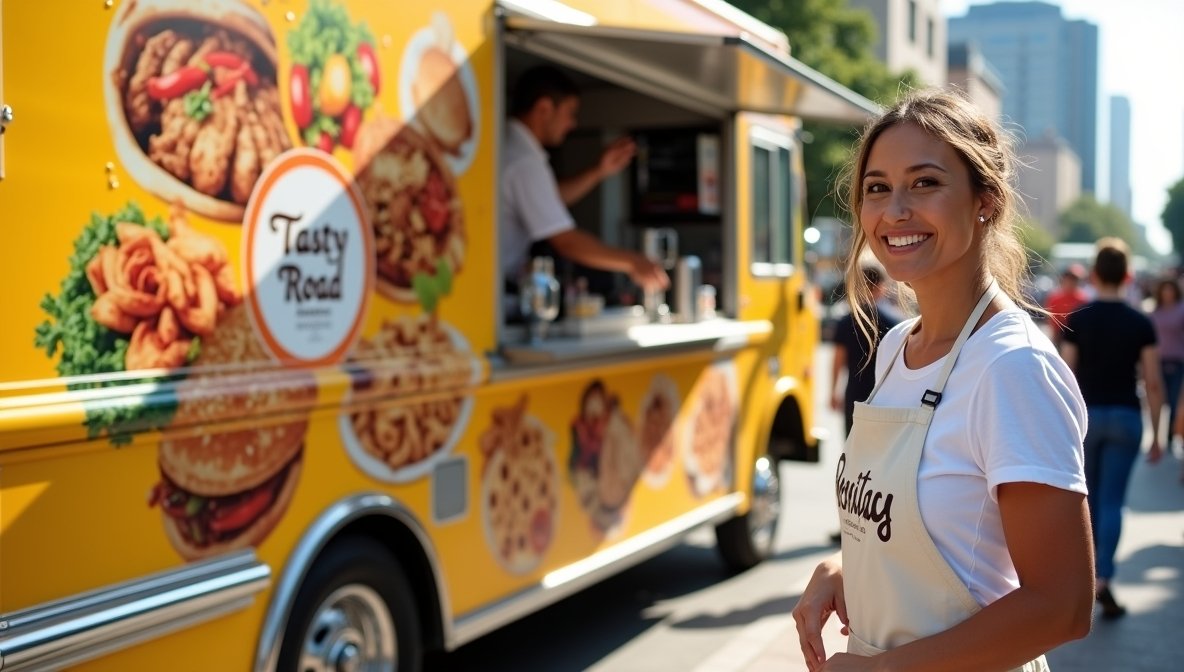Inside the Freshest Campus Food Cart: Serving Affordable Eats to Students
Estimated reading time: 5 minutes
- Market potential of $10 million annually with a $400,000 target.
- 60% gross margin indicating strong profitability.
- Unique selling propositions cater perfectly to student needs.
- Multiple strategies create effective market penetration.
- Strong case studies illustrate learning opportunities.
Table of Contents
- Market Opportunity
- Financial Snapshot
- What Sets You Apart
- Go-to-Market Strategy
- Risks & Mitigations
- Next Steps
- Case Studies
- FAQ
Market Opportunity
The market for mobile food services is thriving, with a total addressable market (TAM) of a staggering $10 million per year. This projection narrows down to a serviceable obtainable market (SOM) of approximately $400,000 annually by targeting students specifically. With an ambitious growth trajectory, the potential for capturing $4 million per year by catering directly to this demographic signals robust market interest and confirming the viability of mobile food services among active university campuses. Just think: with a TAM of 10 million dollars, the opportunity is ripe for those aiming to cater to hungry students looking for convenient and affordable dining options. Learn more about market sizes on Statista.
Financial Snapshot
Understanding the financial landscape of a food cart business is crucial for prospective investors and entrepreneurs. Here’s a concise breakdown:
- Gross Margin: 60% – This indicates a healthy profit after accounting for the cost of goods sold. Explore how to calculate margins.
- Customer Acquisition Cost (CAC): $5 per customer – Efficient marketing strategies ensure that acquiring new students to patronize the cart remains affordable. Learn more about optimizing CAC.
- Customer Lifetime Value (LTV): $20 per customer – This value signifies how much each student is likely to spend over time, reaffirming the investment’s profitability. Understand LTV for sustainable growth.
- Runway: 3 months – This is the time a business can operate before requiring additional capital, emphasizing the importance of swift execution. Read insights on runway management.
- Payback Period: 6 months – Rapid return on investment showcases the appealing nature of the business model. Get more details about payback periods.
What Sets You Apart
Your food cart will thrive based on unique selling propositions (USPs) that resonate well with the student market:
- Mobile Convenience – Reaches students directly on campus, reducing the need for them to travel. Check out how mobile food concepts are winning.
- Affordable Pricing – Fits within the tight budgets of students while offering quality meals. See how pricing strategies impact sales.
- Fresh, Local Ingredients – Stands out by emphasizing quality and local sourcing that appeals to the growing demand for sustainability. Find out how local sourcing impacts customer choices.
Go-to-Market Strategy
A structured marketing approach is vital for capturing your target audience effectively:
- Social Media – Reports show an impressive ROI of 150%, allowing businesses to engage directly with students through popular platforms. Check out the effectiveness of social media.
- On-Campus Presence – Directly interacting with students through events increases visibility, engagement, and potential for consistent sales growth. Look into maximizing opportunities on campus to reach your audience directly.
- Partnerships with Local Organizations – Collaborating with universities and student groups can further enhance reach and establish a loyal customer base. Discover tactics for successful partnerships.
Risks & Mitigations
Risk assessment ensures you’re prepared for challenges ahead:
- Food Safety and Hygiene Concerns: Mitigated by strict adherence to health regulations with regular inspections. Read about best practices in food safety.
- Supply Chain Disruption: Mitigated by establishing multiple supplier relationships to ensure a steady supply of fresh ingredients. See strategies for a resilient supply chain.
Next Steps
To get your food cart off the ground, consider these focused strategies:
- Secure Initial Capital: Aim for an investment of $30,000 for the food truck, permits, food stock, and marketing to kickstart operations. Check out a guide on funding resources.
- Streamline the Supply Chain: Work with multiple local suppliers to mitigate risk and ensure quality control. Learn more on efficient supply chains.
- Engage on Social Media: Initiate targeted marketing using student influencers to amplify brand visibility and customer engagement. Explore how to maximize social media strategies.
Case Studies
Here are a few case studies of successful ventures that can provide insights for your own food cart:
- Campus Cuisine
- Outcome: Success
- Lesson Learned: Engaging students through personalized marketing efforts significantly enhances customer loyalty. Read more here.
- Foodie on Wheels
- Outcome: Fail
- Lesson Learned: A lack of adaptability to changing customer preferences resulted in decline—reminding us that flexibility is crucial in mobile food services. Find out more about their challenges.
- Nomad Bites
- Outcome: Success
- Lesson Learned: Consistency in quality and positioning can build a strong brand presence on campus and ensure repeat business. Check out the insights from their journey.
FAQ
Here are some common questions:
- What is the primary target market for the food cart? The primary target market is university students on campus.
- How is pricing determined for meals? Pricing is kept affordable to cater to students’ budgets while maintaining quality.
- What measures are taken to ensure food safety? Strict adherence to health regulations and regular inspections are implemented to ensure food safety.
- How can the food cart grow its customer base? Through effective use of social media, on-campus presence and partnerships with local organizations.

